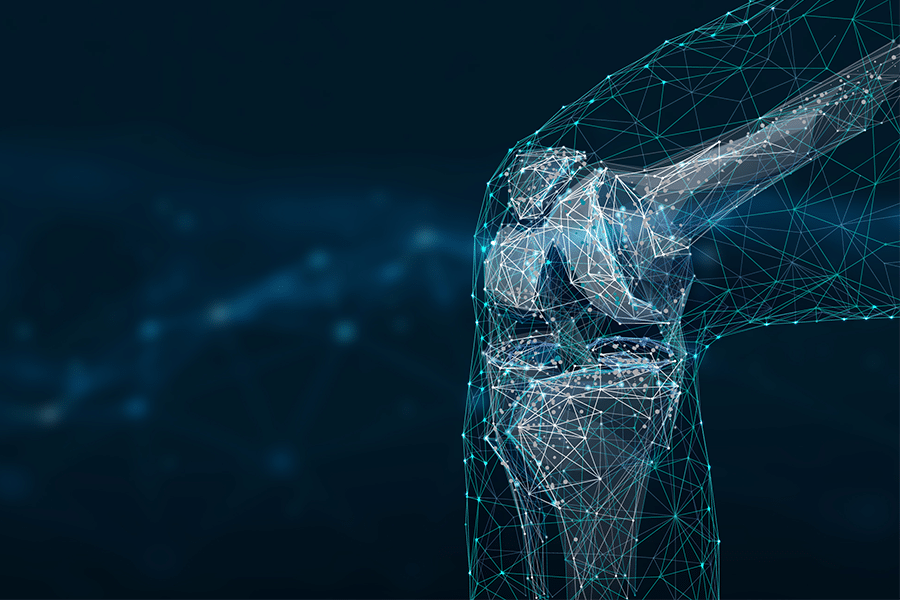A Giant Leap Forward for Joint Arthroplasty
Total knee arthroplasty is one of the most performed procedures in orthopedic surgery. With the geriatric population on the rise, the frequency of this procedure will only increase. During this procedure, the affected parts of a person’s knee joint are replaced with femoral and tibial components. This helps to alleviate pain and restore movement. In order to achieve the best possible fit and reduce complications after the surgery, implants can be personalized for each patient, particularly when unusual anatomical features are present. Machine learning methods have been widely applied to various biomedical image analyses, and one of the emerging applications of machine learning is to enable the automatic customization of medical implants from 3D imaging data, such as computed tomography (CT) scans1. This can potentially improve the quality and efficiency of implant design and fabrication, as well as reduce the costs and risks associated with manual methods.
What usually happens is that Computerized Tomography (CT) imaging is used to acquire the necessary geometric information that is saved as Digital Imaging and Communication in Medicine (DICOM) files. A manual segmentation process is then required to create 3D models of the patient’s anatomy, which is a laborious and time-consuming task2. Designing individualized implants further requires a manual process which results in longer lead times, higher costs, and less frequent use of customized Total Knee Replacement (TKR) procedures compared to non-customized ‘off-the-shelf’ options.
The ambition is to use medical image processing methods based on machine learning to bring forth a ‘mass-customization’ pipeline for the automated design of customized products for many individuals. This would make the fabrication of customized implants faster and less expensive, thereby making the many potential advantages of customization more accessible.
Burge et al. recently conducted a study based on machine-based learning. This research paper presented a fully automatic pipeline for processing CT scans and designing customized implant components for Total Knee Replacement (TKR) using machine learning. The pipeline was tested on 84 femurs and 81 tibias, and the results showed that it could consistently produce highly accurate outcomes. The implant designs were created in under 10 minutes, which could lead to significant time and cost savings compared to current customization methods. Moreover, the pipeline can be operated without the need for highly trained personnel3.
Compared to the X-ray-based tool presented by Burge et al. (2016), the CT-based pipeline demonstrated superior performance for both femurs and tibias across all three metrics. Additionally, the CT-based pipeline would not be susceptible to X-ray-related errors, such as issues with subject orientation, alignment, or magnification4. However, using CT scans as input would raise the cost, limit the accessibility of the technology, and increase the patient’s exposure to radiation.
Similar studies were carried out by Ogura et al. on 55 patients (59 knees) who were implanted with ConforMIS ‘Bicompartmental’ custom implants and found that none of the subjects had a discrepancy in the overhang of 3 mm or more. Similarly, Arnholdt et al. also observed no cases of overhang greater than or equal to 3 mm in a study involving 91 patients who were fitted with customized ConforMIS ‘iTotal™ CR G2’ implants, as per their report5.
To implement the automated pipeline in clinical practice, the workflow developed using the conducted studies could be modified so clinicians can easily use it. This would enable them to upload patient CT data and implant design specifications, and the pipeline could be executed remotely on the cloud. Following the completion of the implant designs, the software could directly forward them to a third-party manufacturer for production and subsequent delivery to the clinicians, thereby expediting the surgical process.
This machine-based pipeline has been shown to be precise, swift, and reproducible, and it did not require any user intervention. Moreover, it is easily adaptable and can be implemented for various implant designs and types. Nevertheless, to ensure the comprehensive validation of the proposed pipeline, further testing and training should be conducted with additional data from subjects, employing both computational and clinical approaches.
